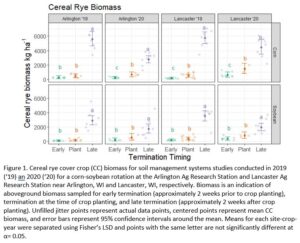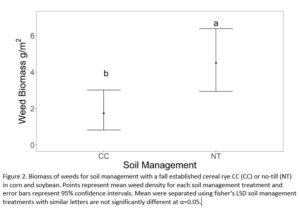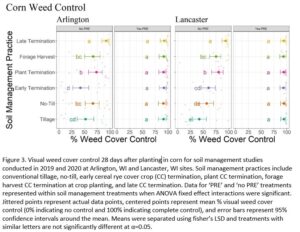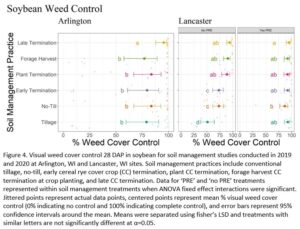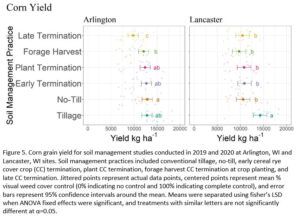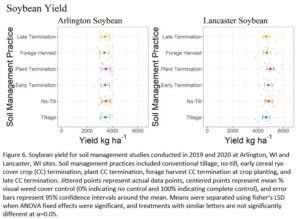Final report for GNC19-275
Project Information
The project titled “Assessment of soil management strategies for sustainable crop production, weed management and mitigation of herbicide carryover” will help farmers to better understand the influence of soil management practices on herbicide carryover, weed ecology, and crop productivity. Research is being conducted in corn-soybean crop production systems in the North Central US with a focus on conventional tillage, no-till (NT), and a fall planted cover crop (CC) as soil management practices.
Two studies involving the aforementioned soil management practices were conducted. The first was designed to study the effects of herbicide carryover from soil residual corn (e.g. mesotrione and clopyralid) and soybean (e.g. imazethapyr and fomesafen) herbicides applied at reduced rates (25% and 50%) following fall harvest of these crops. Soil management practices were implemented following herbicide application. Early-season crop injury and grain yield data were collected to provide results on fate and potential carryover of soil residual herbicides. The second study was designed to evaluate the effects of soil management practices and pre-emergence herbicides on the production system from multiple termination methods and timings of a cereal rye CC. Data collected included aboveground CC biomass for each termination timing, early-season weed density/biomass sampling at the time of crop planting, visual weed cover control ratings at the timing of post-emergence herbicide application, and crop yield. Research for the second study is expected to continue beyond these two years of research until 2022.
The expected outcomes from this project are to increase the adoption of conservation practices (NT+CC) in the North Central US by exploring the ability of these practices to mitigate herbicide carryover and improve the sustainability of weed management strategies in crop production systems. Evaluating how these practices affect multiple aspects of crop production systems results generated from field research should provide information on how conservation practices can improve the sustainability of the production system.
Expected learning outcomes from this project include increased farmer knowledge on the effects of soil conservation practices (NT+CC) on weed population dynamics and herbicide carryover. Farmers will learn how using these soil conservation practices may affect the productivity and profitability of their farms.
Action outcomes of this project are predicted to be increased adoption of NT and CC in North Central production systems as it is expected that these soil conservation practice will have positive impacts on weed population dynamics an herbicide carryover. Showing farmers the potential for multiple benefits from using conservation practices in their production systems should positively influence their behavior and increase the adoption of conservation practices.
Research
Herbicide Carryover Study
Experiments were conducted over the 2019 and 2020 growing seasons at the Arlington Ag Research Station (Arlington, WI), the Lancaster Ag Research Station (Lancaster, WI), and the University of Nebraska Havelock Farm (Lincoln, NE). Both corn and soybean experiments were conducted at all sites during both years, and new fields with no recent use of residual herbicide products were selected for each growing season. These sites were selected based on their representation of local soils used for crop production and to expand this research across the Midwest. Experiments were established in randomized complete block design with four blocks of 3x9.1 m plots, and a five by three factorial treatment structure that included five herbicide treatments (1/4 rate and 1/2 rate each of two herbicide products and a non-treated control) and three soil management practices (conventional tillage, no-till, and a cereal rye CC terminated prior to crop planting). Residual herbicides used prior to corn included imazethapyr (17.5 and 35 g a.e. ha-1, Pursuit, BASF, Research Triangle Park, NC) and fomesafen (65.9 and 131.8 g a.i. ha-1, Reflex, Syngenta, Greensboro, NC); herbicides used prior to soybean included mesotrione (26.3 and 52.6 g a.i ha-1, Callisto, Syngenta, Greensboro, NC) and clopyralid (35.75 and 71.5 g a.e. ha-1, Stinger, Corteva, Indianapolis, IN). Herbicides treatments were applied in the fall with soil management practices being implemented following application. Applying reduced herbicide rates in the fall was done to simulate herbicide which had partially degraded from application in the previous crop, such as would occur from a Summer post-emergence herbicide application.
The cereal rye CC (in Wisconsin, Guardian Winter Rye, La Crosse Seed, La Crosse, WI; in Nebraska, Elbon Cereal Rye, Green Cover Seed, Bladen, NE) was drilled at 67 kg ha-1 with 19 cm row spacing 3.2 cm seeding depth in the fall following the harvest of the previous crop and residual herbicide application. The CC termination with glyphosate (1261.6 g a.e. ha-1, Roundup PowerMAX, Bayer Crop Science, St. Louis, MO) occurred 4-7 days prior to crop planting. Glyphosate was also used for a post-emergence application in all studies to keep experiments weed-free. Wisconsin sites were chisel plowed in the fall following residual herbicide application and field cultivated in the spring prior to crop planting; in Nebraska, an offset disk was used in the Fall following residual herbicide application. Fertility was managed in each experiment according to Wisconsin and Nebraska fertilizer recommendations for optimum nitrogen, phosphorus, and potassium (Laboski and Peters, 2012; Shaver, 2014). Crops were planted with a row-crop planter at 76 cm row spacing and a 3.8 cm seeding depth. The corn hybrid P0339AM (Pioneer, Johnston, IA) was used and it was planted at 80,300 seeds ha-1 in Wisconsin experiments and 79,000 seeds ha-1 in the Nebraska experiment. This hybrid was selected for its sensitivity to ALS herbicides. The soybean variety P22T1R2 (Pioneer, Johnston, IA) was used and it was planted at 345,900 seeds ha-1 in Wisconsin experiments and 370,000 seeds ha-1 in the Nebraska experiment.
Sampling for this research included CC biomass sampling at termination timing, visual ratings of crop injury from herbicide carryover, photos for observing potential crop canopy differences, and crop yield. Aboveground CC biomass was sampled by collecting three subsamples from a 0.09 m2 quadrat, drying samples at 50 °C until constant weight, and recording sample mass. Visual ratings of injury from herbicide carryover were collected at the V3-V4 crop stage in both corn and soybean along with photos for canopy comparisons. Six soybean plants or corn ears were sampled from each plot to assess potential differences in yield components (seed count, seed density, pods/plant, and seeds/pod). Crop yield was collected from the center two rows of each crop with a plot combine.
Soil Management Systems Study
Experiments were conducted over the 2019 and 2020 growing seasons at the University of Wisconsin’s Arlington Ag Research Station and Lancaster Ag Research Station in Wisconsin (Table 1). Both corn and soybean experiments were conducted at both sites over both years. These sites were selected because they represent two distinct areas of agriculturally productive soil in Wisconsin. Fields used were managed with predominantly no-till in recent years which provided a stable soil with predictable weed presence to begin these experiments. Experiments were established in randomized complete block design with four blocks of 3x9.1 m plots, with a six by two factorial treatment structure that included six soil management practices and two pre-emergence (PRE) herbicide treatments (yes PRE or no PRE). Soil management practices included conventional tillage (CT), no-till (NT), and four cover crop termination timings/methods (early termination [CCET] two weeks prior to crop planting, plant termination [CCPT] at the time of crop planting, forage harvest [CCFH] at the time of crop planting, and late termination [CCLT] two weeks after crop planting). Forage harvest of a CC is becoming more common in Wisconsin intending to provide additional feed sources for Dairy farms. Soil management was retained in respective plots as individual experiments progressed in a corn-soybean rotation so that the effects of soil management over time could be studied.
Table 1. Field site background information for experiments conducted in 2019 and 2020 growing seasons at the Arlington Agricultural Research Station and the Lancaster Agricultural Research Station in Wisconsin.
|
Site |
2019 Crop |
Soil Texture |
Soil OM%a |
pH |
2018 CC Planting Dateb |
2019 Crop Planting Date |
2019 CC Planting Dateb |
2020 Crop Planting Date |
|
Arlington |
Corn |
Silt Loam |
3.5 |
6.5 |
1-Oct |
23-May |
5-Nov |
21-May |
|
Soybean |
2.9 |
6.1 |
16-Oct |
|||||
|
Lancaster |
Corn |
Silt Loam |
2.5 |
6.8 |
23-Oct |
23-May |
10-Nov |
20-May |
|
Soybean |
2.4 |
6.3 |
aOM%, soil organic matter %
bCC, cereal rye cover crop
The cereal rye (Guardian Winter Rye, La Crosse Seed, La Crosse, WI) CC was drilled at 67 kg ha-1 (Smith et al., 2019) in the fall following the harvest of the previous crop with a 3.2 cm seeding depth and 19 cm row-spacing. Tillage was completed in CT treatments using a chisel-plow in the fall and field cultivator in the spring prior to crop planting. All experiments were broadcast fertilized annually in the spring, prior to crop establishment, according to Wisconsin fertilizer recommendations for optimum nitrogen, phosphorus, and potassium (Laboski and Peters, 2012). Glyphosate (1261.6 g a.e. ha-1, Roundup PowerMAX, Bayer Crop Science, St. Louis, MO) was used for chemical termination of all CC soil treatments and for a burndown herbicide application at the time of crop planting in NT treatments (Table 2). Crops were planted at 3.8 cm depth using a row-crop planter with 76 cm row-spacing. Corn was planted at 80.3k seeds ha-1. Soybean was planted at 345.9k seeds ha-1. In corn, a pre herbicide mix containing bicyclopyrone, mesotrione, and S-metolachlor (44.9, 179.4, and 1603.6 g a.i. ha-1, respectively. Acuron Flexi, Syngenta, Greensboro, NC) was used for treatments which included a PRE herbicide (Table 2A); in soybean, a PRE herbicide mix containing sulfentrazone and metribuzin (201.9 and 302.8 g a.i. ha-1, respectively. Authority MTZ, FMC Corporation, Philadelphia, PA) was used (Table 2B). Herbicide applications for CC termination, NT burndown, and PRE herbicides were made using a CO2 pressurized backpack sprayer at 140 L ha-1 and a 3 m boom with six TTI110015 nozzles (Spraying Systems Co., Wheaton, IL). A tractor-mounted sprayer was used to apply POST herbicide applications at 140 L ha-1 with a 6.1 m boom with 12 TTI11003 nozzles (Spraying Systems Co., Wheaton, IL) approximately 30 days after crop planting (Table 2A and 2B).
Table 2 Pre-emergence (PRE) and Post-emergence (POST) herbicide application information for corn (A) and soybean (B).
|
Timinga |
NT Burndown & CC Term. |
PRE |
POST |
||||
|
Trade Name |
Roundup PowerMAX |
Acuron Flexi |
Roundup PowerMAX |
Status |
|||
|
Active Ingredient(s) |
glyphosate |
mesotrione |
S-metolachlor |
bicyclopyrone |
glyphosate |
dicamba |
diflufenzopyr |
|
a.i/a.e Rate (g ha-1)b |
1261.6 |
179.4 |
1603.6 |
44.9 |
1261.6 |
140.2 |
56.1 |
|
Adjuvant(s)c |
AMS (1% v/v) |
AMS (1% v/v) |
AMS (1% v/v) |
||||
aNT and CC, no-till and cover crop
ba.i. and a.e, active ingredient and acid equivalent
cAMS, ammonium sulfate
|
Timinga |
NT Burndown and CC Term. |
PRE |
POST |
||
|
Trade Name |
Roundup PowerMAX |
Authority MTZ |
Roundup PowerMAX |
Xtendimax |
|
|
Active Ingredient(s) |
glyphosate |
sulfentrazone |
Metribuzin |
glyphosate |
dicamba |
|
a.i/a.e Rate (g ha-1)b |
1261.6 |
201.9 |
302.8 |
1261.6 |
226.3 |
|
Adjuvant(s)c |
AMS (1% v/v) |
AMS (1% v/v) |
Intact (0.5% v/v) and FS Certain (1% v/v) |
||
aNT and CC, no-till and cover crop
ba.i. and a.e, active ingredient and acid equivalent
cAMS, ammonium sulfate
note: Intact (Precision Laboratories, Waukegan, IL), FS Certain (GROWMARK FS, Bloomington, IL)
Data collection from this study included aboveground cereal rye CC biomass for each termination timing, weed density and biomass at the plant termination timing, visual weed cover control ratings (0-100% with 100% indicating complete control of weed cover) at the post-emergence herbicide application timing, and crop yield.
Preliminary results for crop productivity have been generated for both studies and result for CC biomass and weed suppression 28 days after planting were generated for the soil management systems study. We are still working on analysis of results for most of the herbicide carryover project.
Herbicide Carryover Project
- Early season crop injury was infrequent and variable for the methodology used, indicating methodology should be adjusted to increase potential for herbicide injury if conducting similar research in future experiments.
- Cover crop biomass and canopy coverage data are still in the process of analysis
- Canopeo data for crops is still in the process of analysis
- Grain Yield and yield components data are in the process of analysis
Soil Management Systems Project
Results for weed control 28 days after planting and crop productivity were summarized for each location separately over the two-year period to draw conclusions for the two regions separately.
- The amount of CC biomass often increased the most between the plant and late CC terminations (Figure 1). The CC biomass produced ranged from 77-601 kg ha-1 at early terminations, 141-1455 kg ha-1 at plant terminations, ant 1741-5777 kg ha-1 for late terminations.
- Early season weed suppression between soil management with no-till and a cereal rye CC terminated at the time of crop planting resulted in no reduction of weed density. However, weed biomass was reduced from the use of a CC (Figure 2).
- Weed biomass and density data collected 28 days after planting was deemed impractical for analysis due to inconsistent weed pressure. Only data for weed cover control ratings was included in analysis.
- In corn, weed cover control 28 days after planting was improved at both locations by use of a PRE herbicide for all soil management treatments, except late CC termination (Figure 3). Late CC termination had the best weed cover control when no PRE herbicide was used at both locations (Figure 3).
- In soybean, Use of a PRE herbicide improved overall weed cover control from 77% to 90% at Arlington (p-value= <0.001). Weed cover control in soybean was best in the late CC termination treatment compared to all other soil management practices at Arlington (Figure 4). At Lancaster, the use of a PRE herbicide improved weed cover control in the tillage, no-till, and early CC termination soil management treatments (Figure 4).
- Corn yield was increased by 4.5% from the use of a PRE herbicide at Arlington (p-value= .01494). At Arlington, corn yield was reduced by the late CC termination treatment (Figure 5). At Lancaster, Corn yield was increased for the conventional tillage treatment (Figure 5).
- Soybean yield remained consistent regardless of soil management or PRE herbicide treatments used (Figure 6).
Educational & Outreach Activities
Participation Summary:
We weren’t able to host field days or in-person events to share research findings during the 2020 cropping season and 2020-2021 meeting season. Despite this challenge we were able to continue field activities and share preliminary findings at several virtual events.
Lancaster Waterhemp Management Field Day
This field day occurred on July 10, 2019 at the Lancaster Agricultural Research Station. A mix of growers, agronomists, and extension personnel attended this field day with the main goal of learning how to better manage herbicide resistant waterhemp (Amaranthus tuberculatus), an increasingly problematic weed in summer annual cropping systems. Research from the projects funded by this grant were showcased here to educate producers on how to effectively manage waterhemp depending on the soil management practices used and how use of a cover crop can add to control of herbicide resistant weeds. There were approximately 30 ag professionals and 20 farmers at the event.
Agronomy and Soils Field Day
This field day occurred on August 28, 2019 at the Arlington Agricultural Research Station. A mix of growers, agronomists, and extension personnel attended this field day to gain exposure to a variety of the research being conducted by the University of Wisconsin-Madison faculty. Attendants to our event were informed about our methodology and concepts being researched by our projects focused on weed management in relation to soil management practices. Attendants were most interested in the best implementation of a cover crop and our experience establishing and terminating a cover crop in these trials. There were approximately 100 ag professionals and 50 farmers at the event.
Lancaster Cover Crop Field Day
This field day occurred on September 4, 2019 at the Lancaster Agricultural Research Station. A mix of growers, agronomists, and extension personnel attended this field day to learn about soil conservation and the research being conducted at the research station with a focused on cover crops. Research from the projects funded by this grant were showcased here to educate those present on our management of cover crops in our trials including species selection, establishment, termination, and current observations. There were approximately 20 ag professionals and 10 farmers at the event.
North Central Weed Science Society Poster
A poster was presented at the North Central Weed Science Society annual meeting on December 11, 2019 in Columbus, Ohio. The poster focused on the influence of soil and residue management on herbicide carryover. The poster remained up for the entirety of the meeting and I was present for answering questions and personal presentation for two sessions of two hours each. The audience consisted of approximately 30 ag professionals.
North Central Weed Science Society Talk
An oral presentation accompanied by slides of first-year results was presented at the North Central Weed Science Society annual meeting on December 12, 2019 in Columbus, Ohio. The presentation focused on the influence of soil management practices on weed control, herbicide fate, and crop productivity. The presentation was 15 minutes long including questions from the audience. The audience consisted of approximately 70 ag professionals.
ASA-CSSA-SSSA Annual Meeting Virtual Poster
A poster was presented at the virtual Tri-Societies (ASA-CSSA-SSSA) annual meeting on November 9th-13th, 2020. This poster was made available online for the entirety of the meeting and has been made available online at the meeting website for the time being. The poster focused on changes of pre-emergence herbicide concentration (sulfentrazone and S-metolachlor active ingredients) in soil approximately 28 days after application as a result of soil management. The audience consisted of approximately 50 ag professionals.
North Central Weed Science Society Poster
A poster was presented at the virtual North Central Weed Science Society annual meeting on November 30th-December 3, 2020. This poster was made available online for the entirety of the meeting and I answered questions posted. The poster focused on changes of pre-emergence herbicide concentration (sulfentrazone and S-metolachlor active ingredients) in soil approximately 28 days after application as a result of soil management and included data collected from the systems study. The audience consisted of approximately 50 ag professionals.
Wisconsin Agribusiness Classic Virtual Meeting Presentation
A presentation on preliminary findings from the systems study for this research was given at the virtual 2021 Wisconsin Agribusiness Classic meeting on January 13, 2020. This presentation lasted for 20 minutes. The audience consisted of approximately 50 farmers and 70 ag professionals.
2021 Agronomy Day – Eastern Wisconsin
Preliminary results from the systems study were presented to show the value of integrated weed management in corn-soybean systems. This event took place on February 25th,2021. The audience consisted of approximately 45 farmers and 45 ag professionals.
“Weed Management with Cover Crops” Scientific Journal Article - In Progress
This Scientific journal article includes results on CC biomass, weed suppression, and crop yield from the systems study. This manuscript is intended to be submitted for publication in 2021.
“Soil Management Systems” Scientific Journal Article - In Progress
This Scientific journal article includes results on CC biomass at planting and how it relates to weed suppression between the no-till and plant CC termination timing at the time of crop planting. This manuscript is intended to be submitted for publication in 2021.
“Herbicide Carryover” Scientific Journal Article - In Progress
This Scientific journal article includes all findings from the herbicide carryover research conducted as a part of this grant. This manuscript is intended to be submitted for publication in 2021.
Project Outcomes
One way this project has contributed to agricultural sustainability is by providing Wisconsin farmers with knowledge on how soil conservation practices (CC and NT) can work in their system and how to maintain or improve weed management when using them in corn and soybean production systems. This continued research and our work exploring how soil management influences herbicide carryover will contribute to future sustainability by providing a foundation for similar projects. Findings from our research benefit farmers economically by demonstrating how to use soil conservation practices for optimum weed suppression while reducing potential sacrifices to crop yield. Increasing adoption of soil conservation practices provides environmental benefits for farmers. Social benefits to farmers are experienced as they share information at field days or communicate afterward to implement soil conservation practices. Data on planting green into a cereal rye cover crop is lacking in the region, especially in soybean systems. Research, such as has been conducted by our group, is a good facilitator to help spark the conversation among farmers and ag professionals about using this management practice.
Our knowledge about how cover crops can be realistically integrated into corn and soybean cropping systems of the North Central region of the U.S. increased both from my research and studying research conducted by others. After conducting this research, we believe the use of a cereal cover crop ahead of soybeans is a promising option for improving the sustainability of corn-soybean systems. The concerns over sustainability in these cropping systems included reduced water quality, soil erosion, water infiltration, pest management, and maintaining the related benefits soil provides to society. Using the cover crop practices can help to solve some of these issues by providing another method of weed suppression, reducing the risk of herbicide resistance development and subsequent uncontrollable spread of problematic weeds. A practice such as cover cropping can be used to address some of these concerns. We have also learned that this practice is only one option of many available, including practices such as incorporating perennial forage crops or potentially growing profitable perennial grain crops in the future which could both help improve the sustainability of these systems.
For future research, we plan to continue our efforts working with soil management practices focused on conservation for some of these studies. We would like to be able to adapt some of these studies to field scale and conduct on-farm research which would allow us to interact with farmers more and increase the exposure of practices being used in this research.
Securing funding for conducting this type of research can be difficult, especially when private industry funding can be limited as soil conservation practices are not yet being widely adopted. This research is essential for improving the adoption rate and success of farmers using soil conservation practices and we would not be able to conduct this type of research and provide a good experience for graduate students without funding from publicly sponsored grants such as this one. This grant has been essential to fund my higher education experience and interact with farmers to increase the adoption of soil conservation practices. Thank you!
